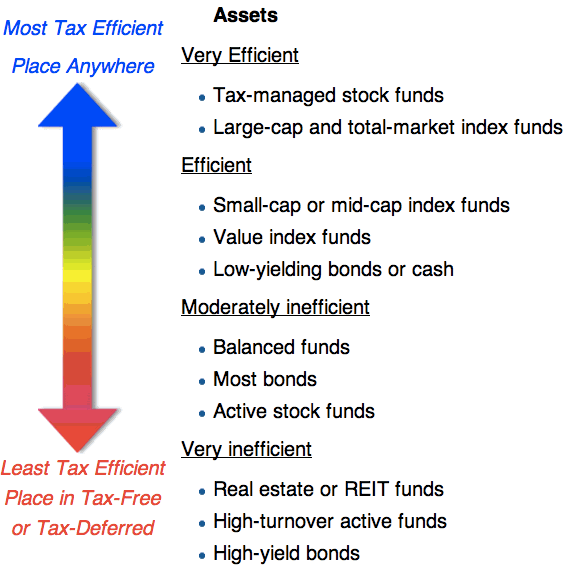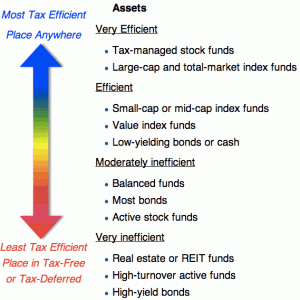Maximizing After-Tax Investment Returns through Asset Location
Aug 3, 2015 • Written by Paul Staib | Certified Financial Planner (CFP®), MBA, RICP®
Blog Home » Asset Allocation » Maximizing After-Tax Investment Returns through Asset Location

You probably already appreciate the beauty of asset allocation. When you spread your money among investment categories that share little in common (such as stocks, bonds, cash, etc.), you help control your portfolio’s risk and squeeze out the highest returns possible for the amount of volatility you can stomach.
Few investors appreciate another smart strategy that goes hand-in-hand with asset allocation. This strategy, called asset location, requires you to consider what type of accounts you should be putting all of those diversified investments into.
Asset location is a tax minimization strategy that takes advantage of the fact that different types of investments receive different tax treatments. Using this strategy, an investor determines which securities should be held in tax-deferred accounts and which securities should be held in taxable accounts in order to maximize after-tax returns. This post will explain who can benefit from this investment strategy, how asset location minimizes taxes and the optimal way to locate assets.
Who Benefits from Asset Location?
For investors to benefit from this strategy, they must have investments in both taxable and tax-deferred accounts. Investors with assets split between taxable and nontaxable accounts and with similar asset mixes will get the largest benefit from asset location. For example, an investor with an asset mix of 40% fixed income and 60% equity will achieve the maximum benefit if the tax-deferred account holds 40% and the taxable accounts holds 60% of total assets. In this case, moving all fixed-income investments into the nontaxable account and all equities into the taxable account will provide the maximum benefit.
Typically, investors who use a balanced investment strategy consisting of equity and fixed-income investments can get the most benefit from asset location. However, investors with all fixed-income or all-equity portfolios can still benefit, albeit not to the same degree.
If an investor is withdrawing funds from tax-deferred accounts or will be doing so in the near future, the benefit of an asset location strategy is greater than it would be for younger investors with many years left before they will start withdrawing funds.
How Asset Location Minimizes Taxes
A typical investor with a balanced portfolio consisting of 60% stocks and 40% bonds might hold investments in both taxable accounts and tax-deferred accounts. Although the investor’s overall portfolio should be balanced, each account does not need to have the same asset mix. Creating the same asset allocation in each account ignores the tax benefit of properly placing securities in the type of account that will assure the best after-tax return.
How a security is taxed will determine where it should be located. Under the current tax code, qualified dividends and capital gains get favorable treatment. While interest income gets taxed as ordinary income rates. The tax rate for qualified dividends and capital gains is only 15% for certain tax brackets. Since most equity investments generate returns from both dividends and capital gains, investors realize lower tax bills when holding stocks or equity mutual funds within a taxable account. Those same capital gains and dividends, however, would be taxed at the ordinary rate (up to 39.6%) if withdrawn from a traditional IRA, 401(k), 403(b), or other type of retirement account where taxes are paid on the withdrawal of funds.
Fixed-income investments, such as bonds and real estate investment trusts (REITs) generate a regular cash flow. Currently, these interest payments are subject to the same ordinary income tax rates of up to 39.6%. A tax-deferred retirement account provides investors with a shelter for this income.
Achieving Optimal Asset Location
Asset location, although it provides for lower taxes, is not a replacement for asset allocation. Only after you determine the proper asset mix for your portfolio can you then locate those investments in the appropriate accounts to minimize the tax drag on your investments.

The best location for an investor’s assets depends on a number of different factors including financial profile, prevailing tax laws, investment holding periods, and the tax and return characteristics of the underlying securities. However, there are some general principles for the types of investments that are best-suited to each type of account.
Taxable Accounts
Tax-friendly stocks should be held in taxable accounts because of their lower capital gains and dividend tax rates and the ability to defer gains. Riskier and more volatile investments belong in taxable accounts both because of the ability to defer taxes and the ability to capture tax losses on poorly performing investments sold at a recognized loss. Index funds, as well as exchange-traded funds (ETFs), are valued for their tax efficiency and should also be held in taxable accounts, as should tax-free or tax-deferred bonds.
Tax-Deferred Accounts
Taxable bonds, REITs and the related mutual funds should be held in tax-deferred accounts. Any mutual funds that generate high yearly capital gains distributions also belong in tax-deferred accounts.
Conclusion
Asset location is a strategy that determines the proper account to place investments in to get the most favorable tax treatment overall. It is not a replacement for asset allocation, but it adds to the overall after-tax return. The best location for a particular security depends on an investor’s financial profile, prevailing tax laws, investment holding periods and the tax and return characteristics of the underlying securities.

Paul Staib | Certified Financial Planner (CFP®), MBA, RICP®
Paul Staib, Certified Financial Planner (CFP®), RICP®, is an independent Flat Fee-Only financial planner. Staib Financial Planning, LLC provides comprehensive financial planning, retirement planning, and investment management services to help clients in all financial situations achieve their personal financial goals. Staib Financial Planning, LLC serves clients as a fiduciary and never earns a commission of any kind. Our offices are located in the south Denver metro area, enabling us to conveniently serve clients in Highlands Ranch, Littleton, Lone Tree, Aurora, Parker, Denver Tech Center, Centennial, Castle Pines and surrounding communities. We also offer our services virtually.
Read Next
Seeking Financial Simplicity
• Written By Paul Staib | Certified Financial Planner (CFP®), MBA, RICP®
Take steps to reduce the stress of managing your money. With today’s economic challenges, it’s not surprising that a growing…
Retirement Savings: 6 Things You Should Know About the SECURE Act
• Written By Paul Staib | Certified Financial Planner (CFP®), MBA, RICP®
The SECURE Act, a law that took effect on January 1, 2020, made significant changes to retirement savings law (the acronym stands…
